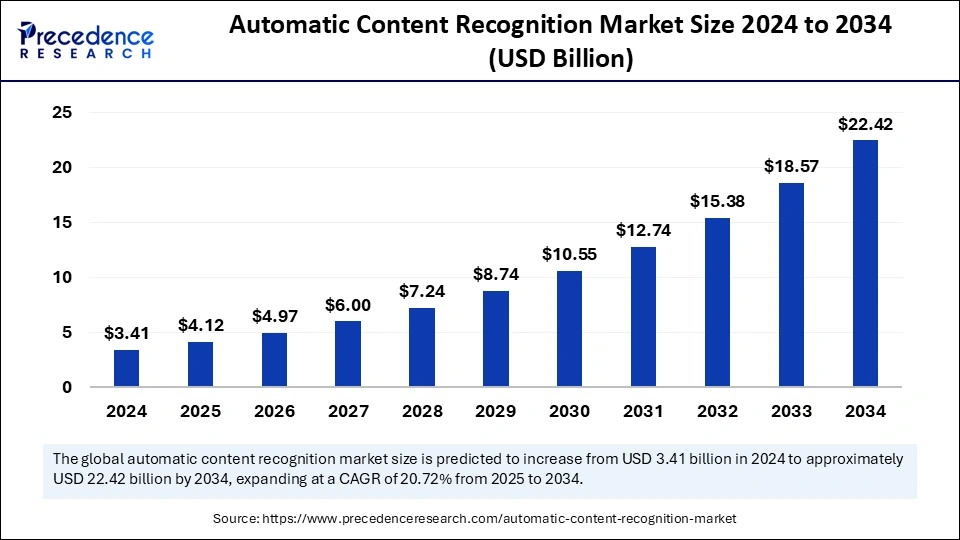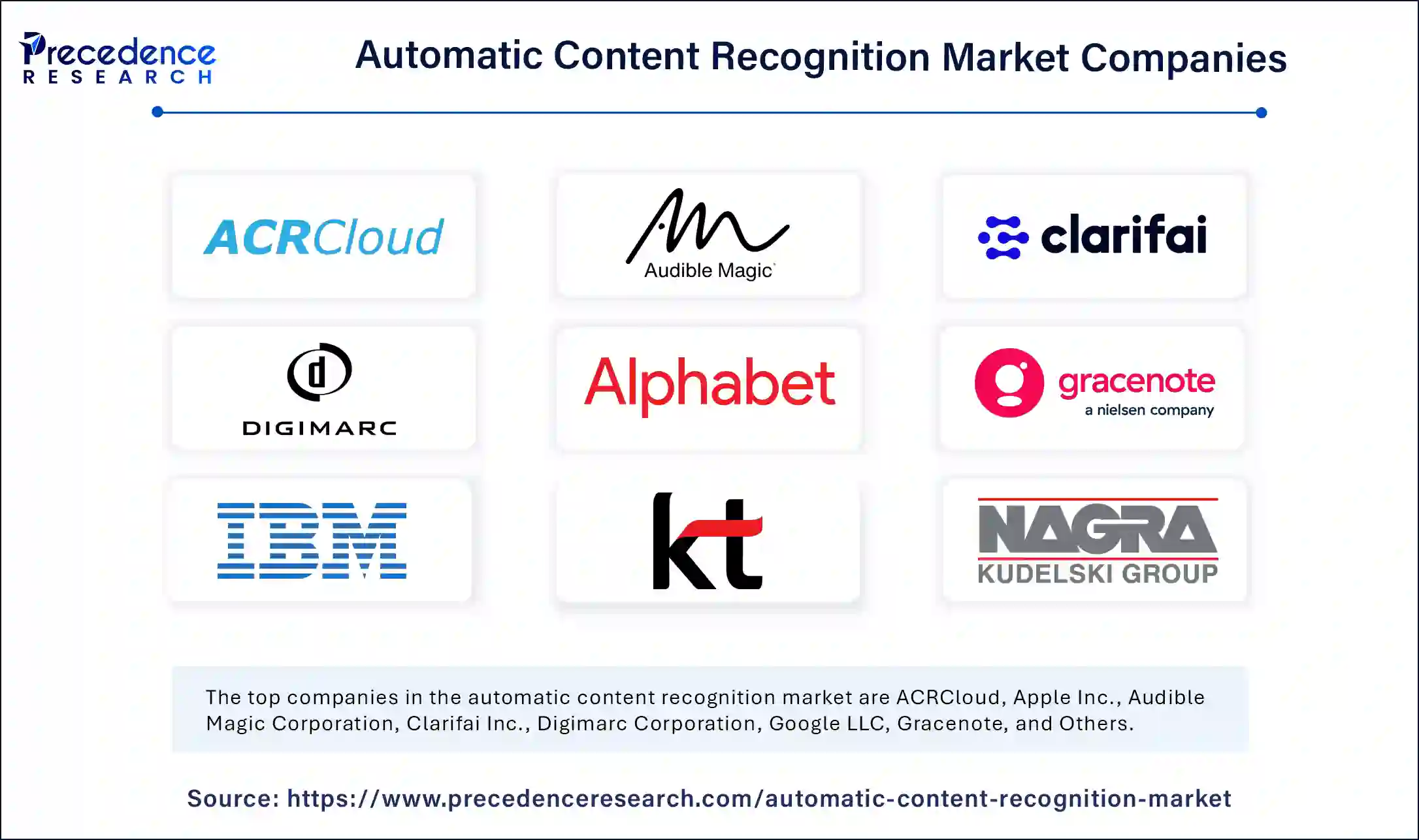The global automatic content recognition market size was valued at USD 3.41 billion in 2024 and is expected to attain around USD 22.42 billion by 2034, growing at a CAGR of 20.72% from 2025 to 2034.

Get a Free Sample Copy of the Report@ https://www.precedenceresearch.com/sample/5758
Key Insights
-
North America was the dominant region, holding a 35% market share in 2024.
-
The Asia Pacific region is projected to witness the fastest expansion, growing at a 22.6% CAGR.
-
The software segment led the market, accounting for 75% of total revenue in 2024.
-
The services segment is expected to grow at a significant CAGR of 21.8% over the coming years.
-
The audio content category had the highest market share in 2024.
-
Video content recognition is forecasted to grow at the highest rate throughout the forecast period.
-
Smart TVs emerged as the primary platform for automatic content recognition in 2024.
-
The OTT segment is likely to experience accelerated growth in the future.
-
The audio & video fingerprinting segment dominated the market in 2024.
-
The optical character recognition technology segment is set to achieve the highest growth between 2025 and 2034.
-
Media & entertainment remained the top industry vertical in 2024.
-
The healthcare sector is projected to grow at the highest CAGR in the coming years.
-
Audience measurement applications dominated in 2024.
-
Ad-tracking applications are expected to experience significant growth over the projection period.
What is Automatic Content Recognition (ACR)?
Automatic Content Recognition (ACR) is a technology that enables devices to recognize audio, video, or images automatically without requiring user input. ACR is commonly used in smart TVs, mobile apps, and streaming services to identify media content and provide relevant information, recommendations, or interactive experiences. By analyzing digital signals, ACR can detect specific content, track viewership patterns, and synchronize multimedia across devices in real time.
How ACR Works
ACR works by using advanced algorithms such as fingerprinting, watermarking, and optical character recognition (OCR) to analyze and identify media content. These technologies compare audio or video snippets with a database to detect matches. When content is recognized, the system can deliver contextual data, such as metadata, additional content, or targeted advertisements, enhancing user engagement and improving content monetization.
Applications of ACR
-
Media & Entertainment: ACR helps streaming platforms and broadcasters analyze audience engagement, personalize content recommendations, and track viewership metrics.
-
Advertising & Marketing: Brands use ACR to measure ad effectiveness, track consumer interactions, and deliver targeted advertising based on real-time content recognition.
-
Smart TVs & OTT Platforms: ACR enables interactive TV experiences, second-screen applications, and personalized streaming suggestions.
-
Healthcare & Education: In healthcare, ACR aids in analyzing medical imaging and transcribing audio data, while in education, it enhances remote learning through speech recognition and automated captioning.
Role of AI in the Automatic Content Recognition (ACR) Market
1. Enhancing Content Identification and Tagging
AI-driven ACR systems improve content identification by automatically recognizing audio, video, and text elements within digital media. Machine learning algorithms analyze and tag content in real-time, making it easier for businesses to categorize and distribute media efficiently.
2. Personalized Recommendations and Audience Insights
AI-powered ACR helps media platforms and advertisers deliver personalized content recommendations based on user preferences. By analyzing viewing patterns and engagement metrics, AI enhances user experience and drives higher engagement.
3. Real-time Ad Tracking and Optimization
AI plays a crucial role in tracking advertisements in live broadcasts and digital streaming platforms. By identifying ads in real time, AI-driven ACR ensures that brands monitor their campaigns, measure effectiveness, and optimize ad placements for maximum impact.
4. Advanced Copyright Protection and Piracy Detection
AI-based ACR enhances copyright protection by detecting unauthorized use of digital content across various platforms. It helps content creators and media houses track content distribution and take action against piracy, ensuring fair revenue distribution.
5. Improving Smart Device Integration
With the rise of smart TVs, OTT platforms, and connected devices, AI-driven ACR enables seamless content synchronization across multiple screens. AI allows smart devices to recognize content playing nearby and offer interactive experiences for users.
6. Real-time Audience Measurement and Analytics
AI helps media companies and broadcasters analyze audience engagement by tracking what content is being watched or listened to in real time. This enables advertisers and content creators to refine their strategies based on data-driven insights.
7. Speech and Image Recognition for Accessibility
AI-powered ACR enhances accessibility features by enabling automatic speech-to-text transcription and image recognition. This benefits users with disabilities by providing captions, translations, and voice-controlled interactions.
8. Strengthening Security and Fraud Detection
AI algorithms enhance security by detecting deepfake content, fake news, and manipulated media. ACR systems can authenticate content sources and verify media authenticity, preventing misinformation.
Market Overview
The Automatic Content Recognition (ACR) market is growing significantly due to the increasing use of smart devices and AI-driven analytics. ACR technology plays a crucial role in enhancing user experiences by enabling automatic identification of media content and delivering real-time insights for content providers. The demand for ACR is expanding across various industries, including entertainment, advertising, retail, and smart home automation.
Automatic Content Recognition (ACR) Market Growth Factors
-
Rising Demand for Personalized Content
As consumers demand more personalized experiences, ACR enables platforms to analyze user preferences and behavior, providing tailored content recommendations. This growing need for personalized services is driving the adoption of ACR across various sectors, including streaming services, smart TVs, and mobile applications. -
Increasing Usage of Smart Devices
The growing penetration of smart TVs, mobile devices, and other connected devices is boosting the ACR market. With the rise of IoT and smart home devices, ACR technology is becoming an integral part of enhancing user experience and interaction with these devices, encouraging further market growth. -
Expansion of Streaming Services
The rise of Over-The-Top (OTT) platforms and video-on-demand services has increased the need for ACR. Content providers use ACR to analyze viewer preferences, improve user engagement, and streamline advertising strategies. ACR technology enables more accurate audience measurement, improving content delivery and monetization on streaming platforms. -
Adoption of AI and Machine Learning
The integration of artificial intelligence (AI) and machine learning technologies into ACR systems is driving the market forward. AI enhances content recognition accuracy and allows for smarter, more efficient content management. This integration also facilitates real-time content analysis and contextual advertising, providing a significant growth opportunity for ACR solutions. -
Growing Demand for Real-Time Data
ACR technology plays a pivotal role in capturing real-time data, especially in applications like audience measurement, ad tracking, and content synchronization across platforms. As businesses across industries seek to leverage real-time data for better decision-making, the demand for ACR solutions continues to grow. -
Expansion of Advertising and Marketing Capabilities
ACR is increasingly being used to enhance advertising strategies, enabling targeted ad placements based on real-time content recognition. This is particularly valuable in industries like media and entertainment, where the ability to track and respond to consumer behavior is crucial for improving ad revenues and maximizing engagement. -
Increased Investment in Media and Entertainment
The rapid expansion of the media and entertainment industry, coupled with the growing number of digital content creators, is pushing the adoption of ACR for enhanced audience analysis and content interaction. ACR helps businesses in the sector improve content delivery, optimize content monetization, and enhance user experiences. -
Support for Cross-Platform Content Recognition
With content being consumed across a wide range of devices, ACR’s ability to provide seamless cross-platform content recognition has become an important growth factor. As consumers watch content across multiple screens, ACR enables a consistent and synchronized experience, leading to greater market adoption across various platforms and industries.
Market Scope
| Report Coverage | Details |
| Market Size by 2034 | USD 22.42 Billion |
| Market Size in 2025 | USD 4.12 Billion |
| Market Size in 2024 | USD 3.41 Billion |
| Market Growth Rate from 2025 to 2034 | CAGR of 20.72% |
| Dominated Region | North America |
| Fastest Growing Market | Asia Pacific |
| Base Year | 2024 |
| Forecast Period | 2025 to 2034 |
| Segments Covered | Component, Content, Platform, Technology, Industry Vertical , Application, and Regions |
| Regions Covered | North America, Europe, Asia-Pacific, Latin America and Middle East & Africa |
Market Dynamics
Market Drivers
Key drivers of the ACR market include the proliferation of connected devices, the rising need for audience measurement in digital advertising, and advancements in AI-powered content recognition. Companies are leveraging ACR to improve targeted marketing, track consumer engagement, and enhance real-time content recommendations. The increasing shift towards data-driven decision-making is also accelerating ACR adoption.
Market Opportunities
The growth of AI and machine learning is creating new opportunities for ACR, particularly in enhancing content curation and media analytics. Additionally, the expansion of ACR applications in industries such as automotive (for in-car entertainment systems), healthcare (for diagnostic imaging analysis), and e-commerce (for visual search and recommendation engines) is broadening the market’s potential.
Market Challenges
Challenges in the ACR market include concerns over user data privacy and regulatory compliance, as governments worldwide implement stricter data protection policies. Additionally, the high costs associated with developing and maintaining ACR technology may limit its adoption among smaller enterprises. Ensuring seamless interoperability between ACR solutions and diverse digital platforms also remains a hurdle.
Regional Insights
North America remains the leading region in ACR adoption, supported by advanced digital marketing practices and widespread smart device usage. The Asia Pacific region is experiencing rapid growth, driven by increasing investments in digital infrastructure and rising consumer demand for personalized content experiences. Europe follows closely, with a strong focus on AI-driven advertising strategies and regulatory frameworks that support innovation in media technology.
Recent Developments
- In December 2022, VIZIO announced a census-representative panel built using automatic content recognition (ACR) data from Inscape, VIZIO’s ACR data subsidiary.
- In September 2022, LG Electronics (LG) announced a rollout of LG Ads Solutions proprietary automatic content recognition (ACR) technology across LG TVs.
Automatic Content Recognition Market Companies

- ACRCloud
- Apple Inc.
- Audible Magic Corporation
- Clarifai Inc.
- Digimarc Corporation
- Google LLC (Alphabet Inc.)
- Gracenote
- IBM Corporation
- KT Corporation
- Kudelski Group
- Microsoft Corporation
- Nuance Communications Inc.
Segments Covered in the Report
By Component
- Software
- Services
By Content
- Audio
- Video
- Text
- Image
By Platform
- Smart TVs
- Linear TVs
- Over-The-Top (OTT)
- Others
By Technology
- Audio & Video Watermarking
- Audio & Video Fingerprinting
- Speech Recognition
- Optical Character Recognition (OCR)
- Others
By Industry Vertical
- Media & Entertainment
- IT & Telecommunication
- Automotive
- Retail & E-commerce
- IT & Telecommunication Electronics
- Government & Defense
- Others
By Application
- Audience Measurement
- Content Enhancement
- Broadcast Monitoring
- Content Filtering
- Ad-tracking
- Others
By Region
- North America
- Europe
- Asia Pacific
- Middle East & Africa
- Latin America
Also Read: B2B Continuing Education Market
Ready for more? Dive into the full experience on our website@ https://www.precedenceresearch.com/
- Perishable Prepared Food Market Size to Attain USD 157.77 Bn by 2034 - April 24, 2025
- Fabric Filter Market Size to Attain USD 7.50 Billion by 2034 - April 24, 2025
- Pilot Training Market Size to Attain USD 31.38 Bn by 2034 - April 24, 2025
